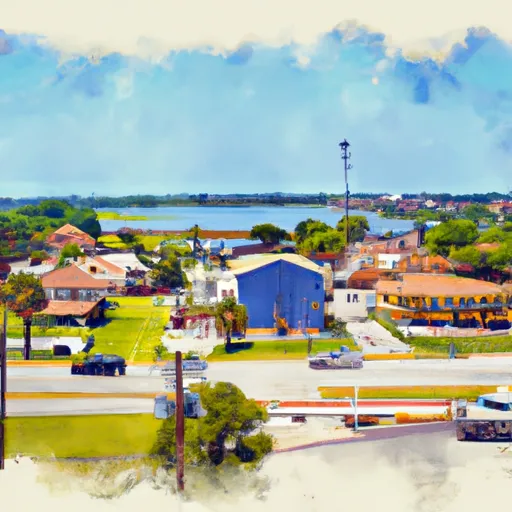-
 Snoflo Premium
Snoflo Premium
Get unlimited access to all our content
With no Ad interruptions! - Start Your Free Trial Login with existing account
Tavares
Eden Index
Climate
7.2
•
Recreation
5.7
•
Community
2.3
•
Safeguard
5.4/10

Tavares, Florida, known as the "Seaplane City," is located in Lake County and offers a unique blend of natural beauty, favorable weather, and exciting outdoor recreation opportunities. Its subtropical climate ensures mild winters and hot summers, making it a popular destination year-round.
Situated on the shores of Lake Dora, Tavares enjoys a rich hydrology. The lake is part of the Harris Chain of Lakes, which provides a diverse range of aquatic activities. Boating, fishing, and water sports enthusiasts can explore the interconnected waterways, while nature lovers can discover the abundant wildlife and picturesque wetlands.
Outdoor recreation in Tavares extends beyond the water. The city offers numerous parks and trails, including the Hickory Point Recreational Park, where visitors can swim, picnic, play sports, or enjoy a walk along the scenic shoreline. The Lake Idamere Park boasts hiking trails, a fishing pier, and a playground.
Furthermore, Tavares hosts various events throughout the year, such as seaplane fly-ins and fireworks displays, providing entertainment and fostering community spirit. With its pleasant climate, hydrological features, and diverse outdoor attractions, Tavares offers residents and visitors ample opportunities to enjoy the natural beauty of Central Florida.
What is the Eden Index?
The Snoflo Eden Index serves as a comprehensive rating system for regions, evaluating their desirability through a holistic assessment of climate health, outdoor recreation opportunities, and natural disaster risk, acknowledging the profound impact of these factors on livability and well-being.
Climate Health Indicator (CHI): 7.2
Tavares receives approximately
1268mm of rain per year,
with humidity levels near 88%
and air temperatures averaging around
22°C.
Tavares has a plant hardyness factor of
9, meaning
plants and agriculture in this region tend to thrive here all year round.
By considering the ideal temperature range, reliable water supplies, clean air, and stable seasonal rain or snowpacks, the Climate Health Indicator (CHI) underscores the significance of a healthy climate as the foundation for quality living.
A healthy climate is paramount for ensuring a high quality of life and livability in a region, fostering both physical well-being and environmental harmony. This can be characterized by ideal temperatures, reliable access to water supplies, clean air, and consistent seasonal rain or snowpacks.
Weather Forecast
Streamflow Conditions
St. Johns
Area Rivers
St. Johns
Snowpack Depths
St. Johns
Reservoir Storage Capacity
St. Johns
Groundwater Levels
Recreational Opportunity Index (ROI): 5.7
The Recreational Opportunity Index (ROI) recognizes the value of outdoor recreational options, such as parks, hiking trails, camping sites, and fishing spots, while acknowledging that climate plays a pivotal role in ensuring the comfort and consistency of these experiences.
Access to outdoor recreational opportunities, encompassing activities such as parks, hiking, camping, and fishing, is crucial for overall well-being, and the climate plays a pivotal role in enabling and enhancing these experiences, ensuring that individuals can engage in nature-based activities comfortably and consistently.
Camping Areas
| Campground | Campsites | Reservations | Toilets | Showers | Elevation |
|---|---|---|---|---|---|
| Trimble County Park | 15 | 65 ft | |||
| Saddle Creek County Park | None | 111 ft | |||
| Clearwater Lake | 62 | 81 ft | |||
| Lake Louisa State Park | None | 154 ft | |||
| Highlands Hammock State Park | None | 136 ft | |||
| Big Bass | 34 | 69 ft | |||
| Magnolia County Park | 96 | 81 ft | |||
| Lake Griffin State Rec Area | None | 85 ft | |||
| Big Scrub | 50 | 145 ft | |||
| Alexander Springs | 181 | 49 ft |
Catastrophe Safeguard Index (CSI):
The Catastrophe Safeguard Index (CSI) recognizes that natural disaster risk, encompassing floods, fires, hurricanes, and tornadoes, can drastically affect safety and the overall appeal of an area.
The level of natural disaster risk in a region significantly affects safety and the overall livability, with climate change amplifying these risks by potentially increasing the frequency and intensity of events like floods, fires, hurricanes, and tornadoes, thereby posing substantial challenges to community resilience and well-being.
Community Resilience Indicator (CRI): 2.3
The Community Resilience Indicator (CRI) recognizes that education, healthcare, and socioeconomics are crucial to the well-being of a region. The CRI acknowledges the profound impact of these elements on residents' overall quality of life. By evaluating educational resources, healthcare accessibility, and economic inclusivity, the index captures the essential aspects that contribute to a thriving community, fostering resident satisfaction, equity, and social cohesion.

